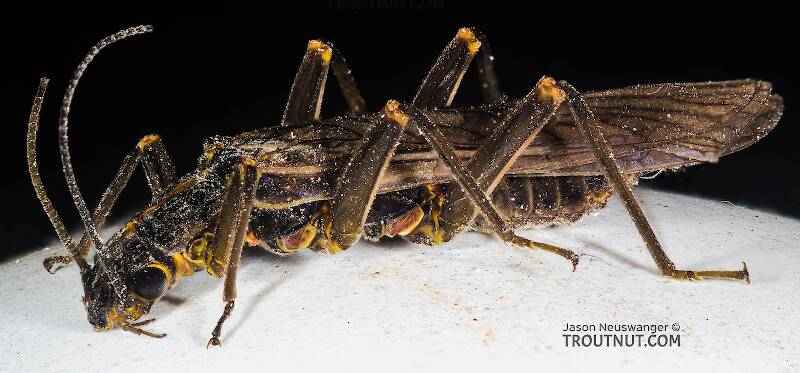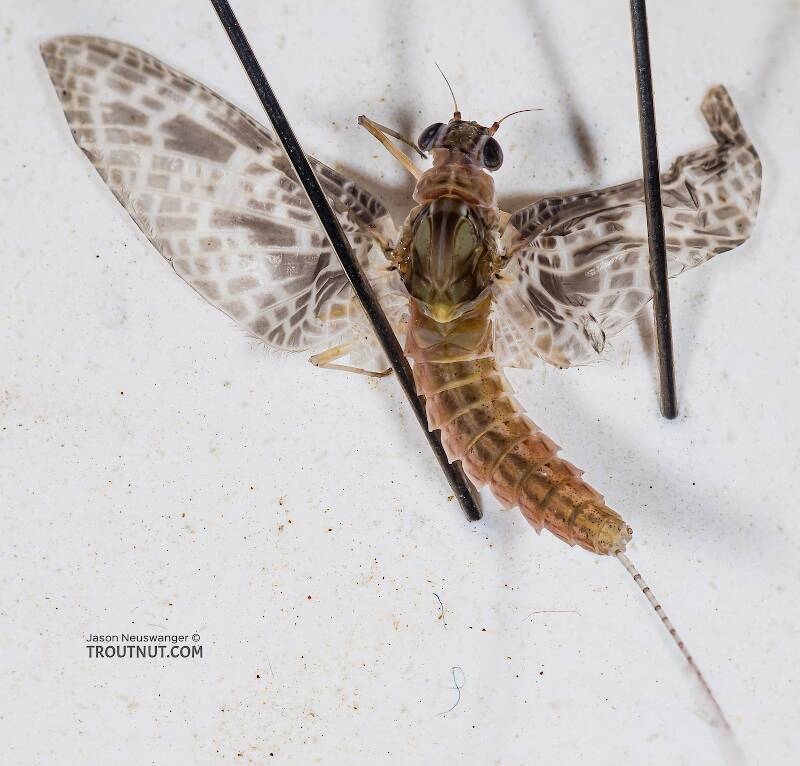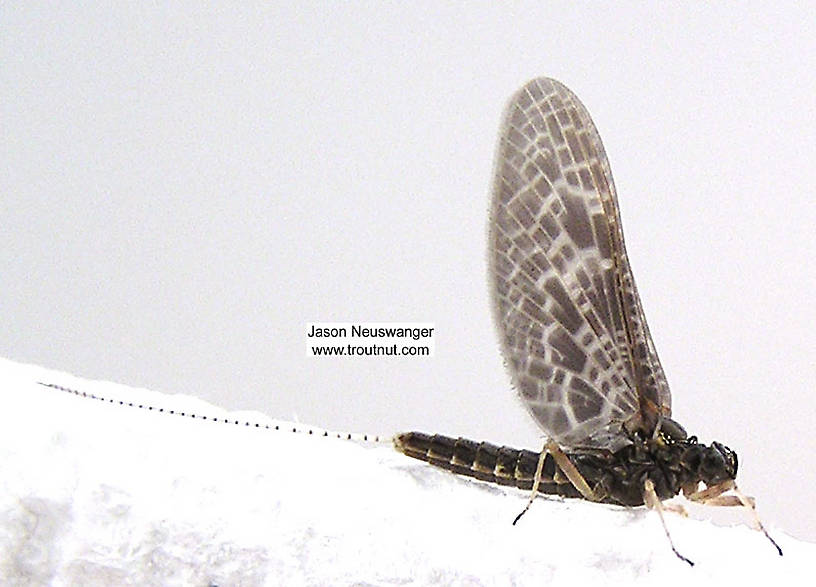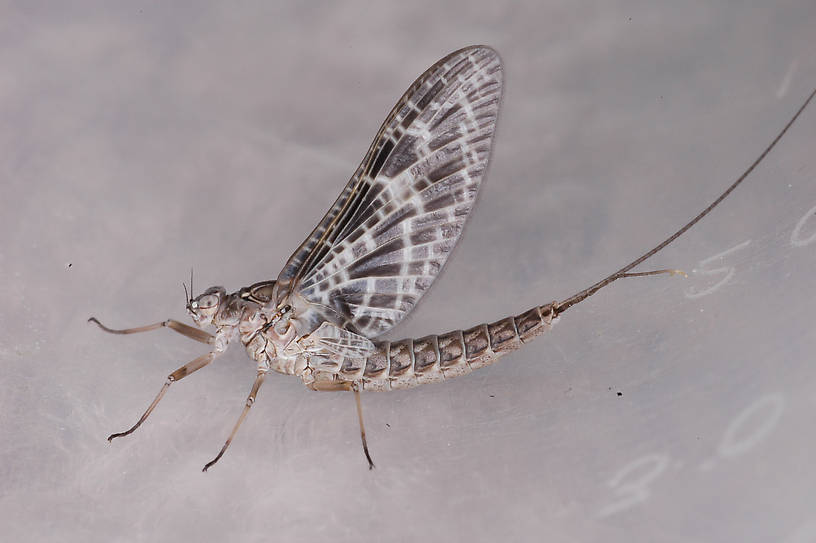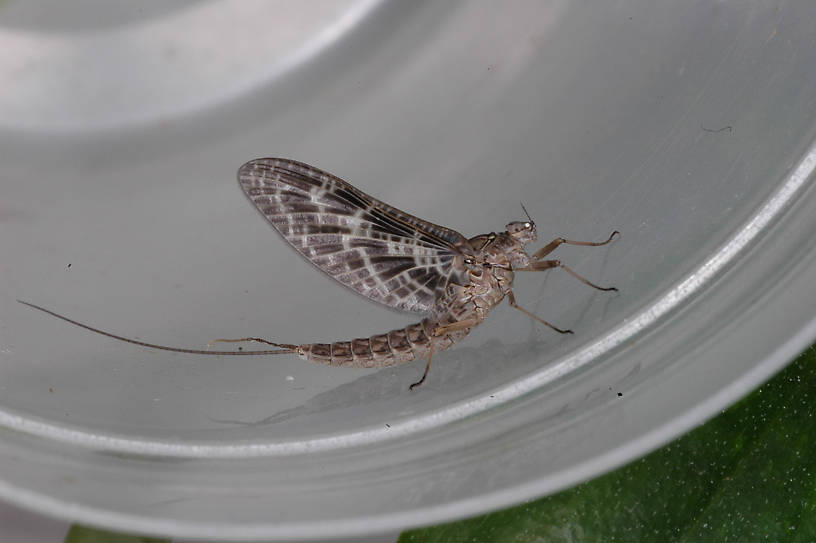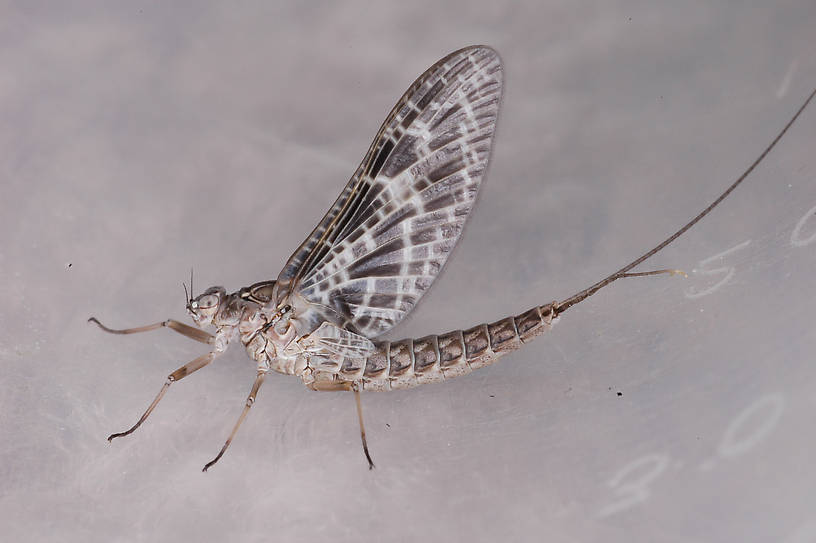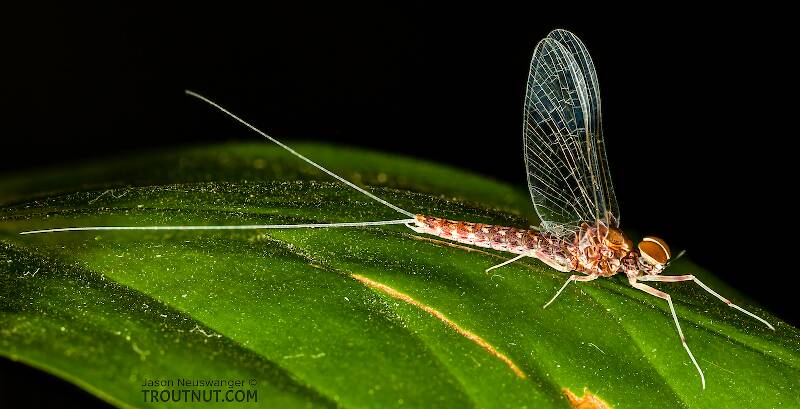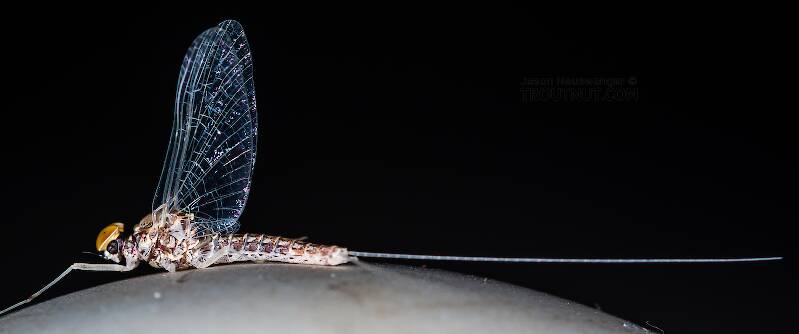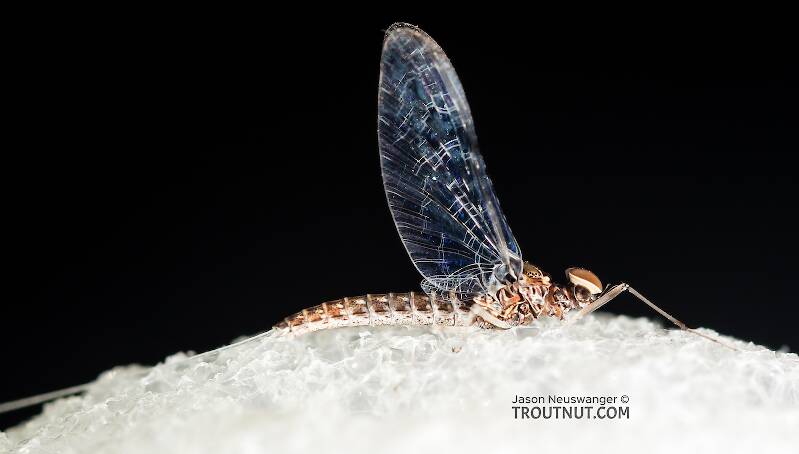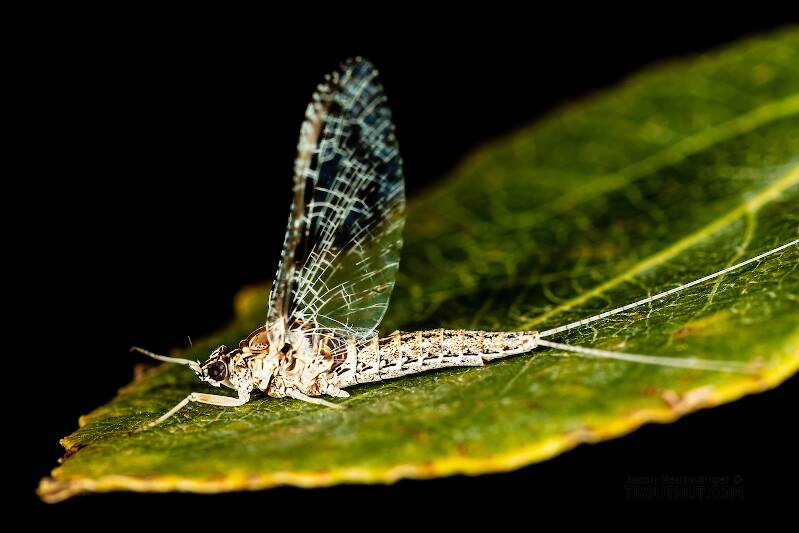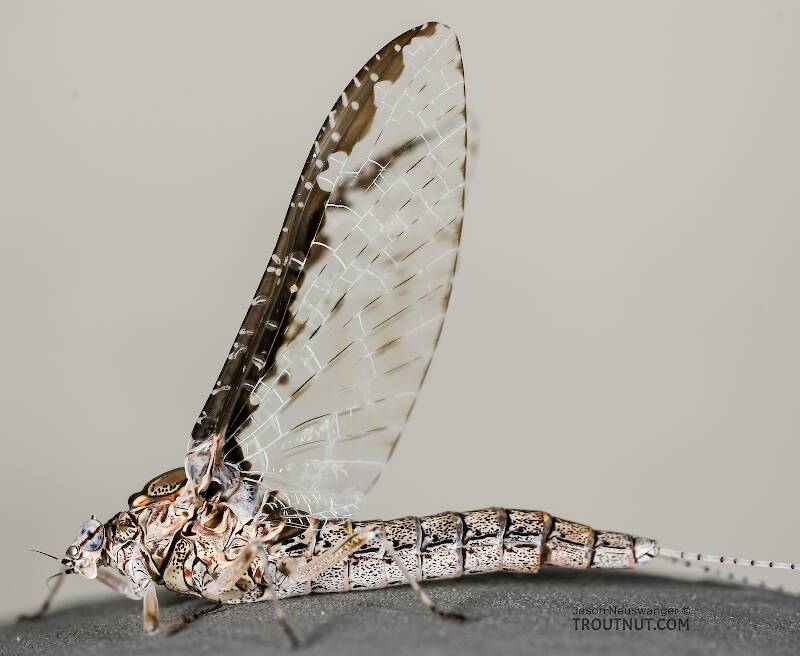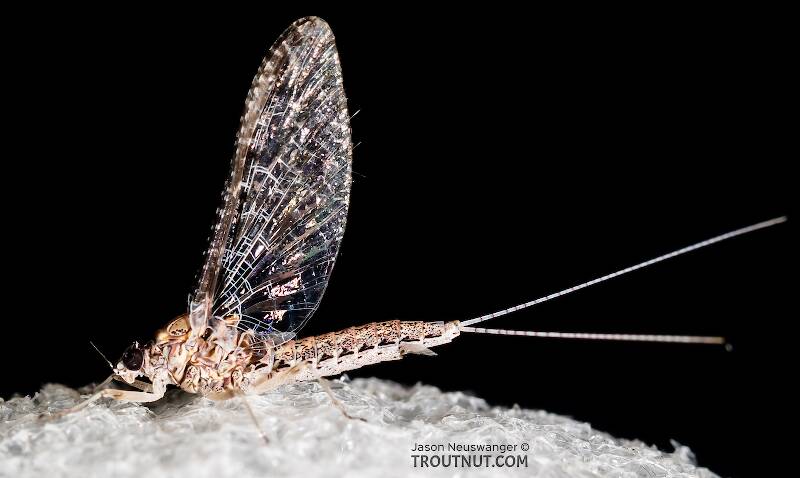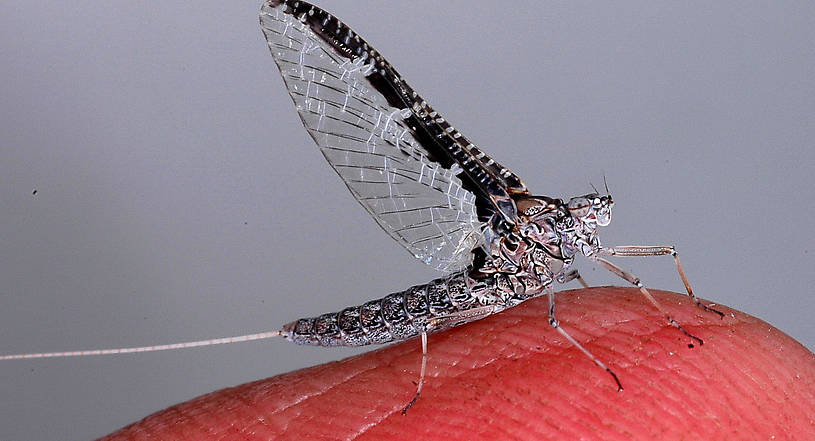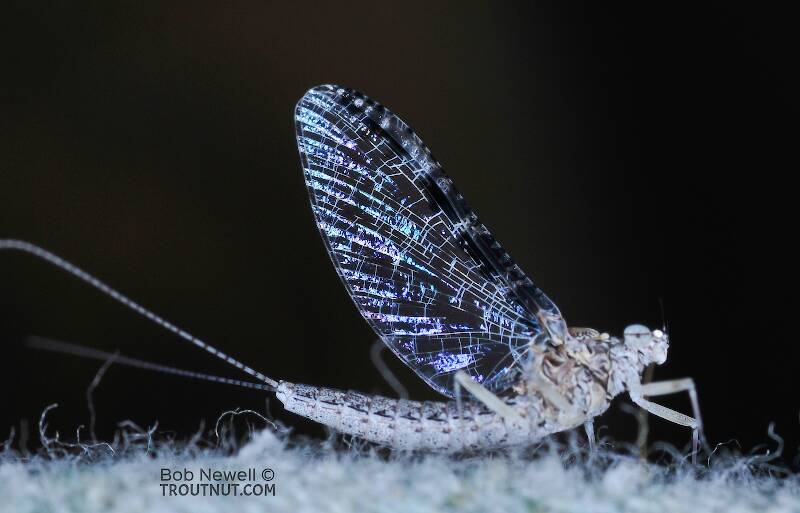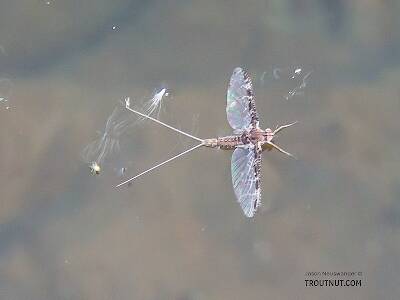
Salmonflies
Pteronarcys californica
The giant Salmonflies of the Western mountains are legendary for their proclivity to elicit consistent dry-fly action and ferocious strikes.
Featured on the forum

Troutnut is a project started in 2003 by salmonid ecologist Jason "Troutnut" Neuswanger to help anglers and
fly tyers unabashedly embrace the entomological side of the sport. Learn more about Troutnut or
support the project for an enhanced experience here.
Mayfly Genus Callibaetis (Speckled Duns)
The speckle winged Callibaetis genus contains on average the largest species in the Baetidae family with hatches ranging in size from 20 to 12 (6mm to 12mm). However, most can be matched with 14 and 16 imitations. They reside only in very slow weedy sections of rivers or lakes and ponds.
The most important are the sub-species Callibaetis ferrugineus ferrugineus in the East and Midwest and Callibaetis ferrugineus hageni in the West. It is in the West however, where this genus achieves its densest populations and most significant hatches. Other important western species also happen to be at both sides of the size scale. The outsized Callibaetis californicus can produce excellent hatches. The diminutive Callibaetis pictus can also be locally prolific, especially at higher elevations.
The duns are easily recognized by their speckled bodies and distinctive wings usually featuring a dark background overlaid with white veins. Female spinners are also easy to recognize with their clear wing's leading edges marked with dark blotches -- see the pictures.
The most important are the sub-species Callibaetis ferrugineus ferrugineus in the East and Midwest and Callibaetis ferrugineus hageni in the West. It is in the West however, where this genus achieves its densest populations and most significant hatches. Other important western species also happen to be at both sides of the size scale. The outsized Callibaetis californicus can produce excellent hatches. The diminutive Callibaetis pictus can also be locally prolific, especially at higher elevations.
The duns are easily recognized by their speckled bodies and distinctive wings usually featuring a dark background overlaid with white veins. Female spinners are also easy to recognize with their clear wing's leading edges marked with dark blotches -- see the pictures.
Where & when
Callibaetis species usually produce two and sometimes up to three broods in a single season. Their peak times vary widely by location.
In 209 records from GBIF, adults of this genus have mostly been collected during July (19%), June (19%), August (18%), May (14%), April (10%), and September (8%).
In 173 records from GBIF, this genus has been collected at elevations ranging from 20 to 12402 ft, with an average (median) of 4288 ft.
Genus Range
Hatching behavior
Callibaetis duns emerge on the surface. They can take flight quickly or ride the water's surface for a lengthy period, depending on circumstances. Knopp and Cormier write in Mayflies: An Angler's Study of Trout Water Ephemeroptera that the nymphs make several trips to and from the surface before hatching, a habit more common in the Ephemerellidae family.The hatch may last for several hours during the cooler weather of spring. In the West, duns most often appear mid-morning before the ever present wind comes up. Soft overcast days are optimal and during these conditions the duns will come off in waves lasting for hours. Mixed with nymphal activity and interpersed with spinner falls, the trout are presented with quite a feast.
Spinner behavior
Time of day: Dusk
They have distinctive flight patterns consisting of foot-long, fast vertical undulations as if they were suspended on invisible rubber bands.
Angling literature is replete with descriptions of this behavior often referred to romantically as the "mating dance."
A very interesting quirk of this genus is evidence that suggests the tiny nymphs hatch from fertilized eggs almost as soon as they hit the water. To make this possible, the females would have to wait on land for an extended period after mating to allow incubation before they can oviposit.
They often spend considerable time on the water either during or immediately after ovipositing and they often do this in a full upright or semi-spent condition, at least at first. This offers excellent dry fly opportunities. The spinner falls can occur at any time during daylight hours so it pays to be observant and prepared. In the West, ovipositing seems to be more dependant on wind than any other factor. As with the duns, during periods of calm they can come on in waves only to dissipate quickly as wind comes back.
Knopp and Cormier offer a good tip for fishing the spinners:
The natural spinner's tails are widely spread, and this trait should be copied on all imitations.
Nymph biology
Current speed: Still or slow
Substrate: Vegetation, silt
Specimens of the Mayfly Genus Callibaetis
1 Male Dun
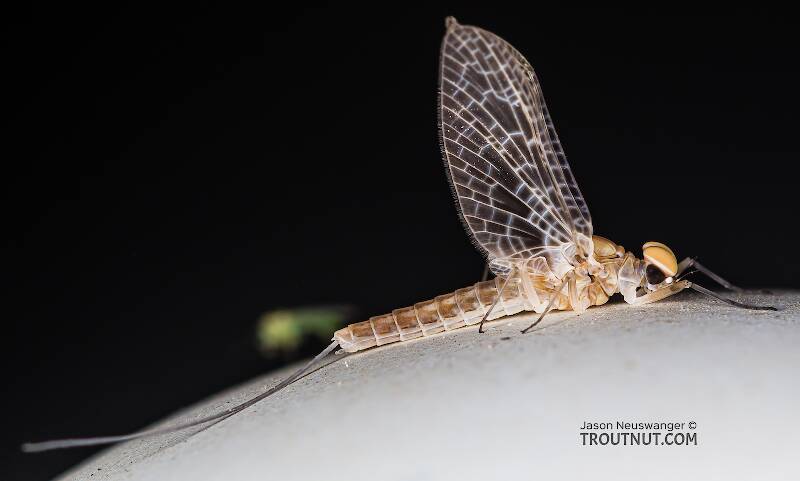
This is one of four specimens I photographed together from the same hatch, also including a nymph, a female dun, and a male spinner.
5 Female Duns
3 Male Spinners
5 Female Spinners
1 Nymph
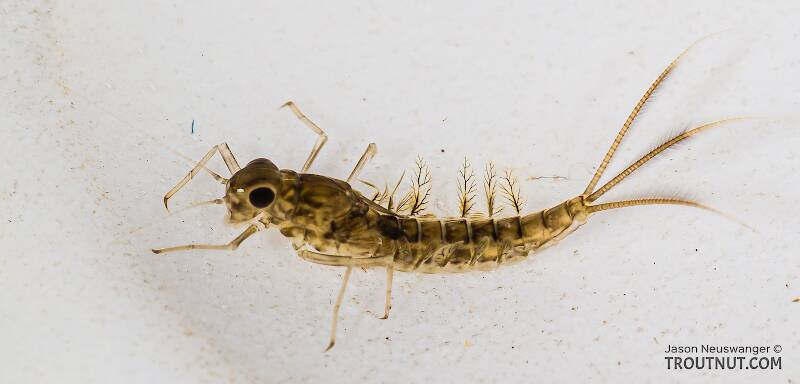
This nymph was one of a horde I could see cruising the still shallows of a cold tailwater, mixed in with an intense emergence of duns. It's one of four specimens I photographed together from the same hatch, also including a male dun, a female dun, and a male spinner.
This nymph keys to either Callibaetis ferrugineous or Callibaetis pallidus. The lack of a darkened preapical band on the femora would suggest pallidus, but I can't definitively make out the "single seta" on the outer, ventral apex of any of the tarsi, the length of which is supposedly a more reliable characteristic to tell the species spart. I can maybe make something out on one of the legs at the highest magnification, and its dimensions would suggest ferrugineous.
This nymph keys to either Callibaetis ferrugineous or Callibaetis pallidus. The lack of a darkened preapical band on the femora would suggest pallidus, but I can't definitively make out the "single seta" on the outer, ventral apex of any of the tarsi, the length of which is supposedly a more reliable characteristic to tell the species spart. I can maybe make something out on one of the legs at the highest magnification, and its dimensions would suggest ferrugineous.
1 Streamside Picture of Callibaetis Mayflies:
Discussions of Callibaetis
Mayfiles other than Callibaetis
1 replies
Posted by Royal_Coach on Jan 15, 2018
Last reply on Jan 15, 2018 by Millcreek
every book/article I read says Baetidae is the most imporant family and Callibaetis the most important genus of mayfly. Why? Does this just mean they are the most prolific? Am I not likely to encounter any other family/genus on a western river?
Callibaetis Spinner Habits
8 replies
Posted by WildcatRob on Sep 8, 2007 in the species Callibaetis ferrugineus
Last reply on Jan 7, 2009 by Dgracia
With almost 40 years lake fishing experience in the Northwest (Washington) our callibaetis always seem to start hatching mid afternoon in the evening, mate overnight then the spinners start in the morning. The spinners draw the most intense "rise." I put rise in quotes because it is so delicate there it leaves almost no disturbance at all not even a sip.
Any comments? Hopefully contradictions?
Rob
Any comments? Hopefully contradictions?
Rob
Start a Discussion of Callibaetis
References
- Arbona, Fred Jr. 1989. Mayflies, the Angler, and the Trout. Nick Lyons Books.
- Caucci, Al and Nastasi, Bob. 2004. Hatches II. The Lyons Press.
- Knopp, Malcolm and Robert Cormier. 1997. Mayflies: An Angler's Study of Trout Water Ephemeroptera . The Lyons Press.
- Leonard, Justin W. and Fannie A. Leonard. 1962. Mayflies of Michigan Trout Streams. Cranbrook Institute of Science.
- Schwiebert, Ernest G. 1955. Matching the Hatch. MacMillan Publishing Company.
Mayfly Genus Callibaetis (Speckled Duns)
Taxonomy
Species in Callibaetis
Callibaetis californicus
0
0
Callibaetis ferrugineusRed Speckled Dun
8
47
Callibaetis floridanus
0
0
Callibaetis fluctuans
0
0
Callibaetis montanus
0
0
Callibaetis pallidus
0
0
Callibaetis pictus
0
0
Callibaetis pretiosus
0
0
Callibaetis skokianus
0
0
Callibaetis undatus
1
2
Species in Callibaetis: Callibaetis californicus, Callibaetis ferrugineus, Callibaetis floridanus, Callibaetis fluctuans, Callibaetis montanus, Callibaetis pallidus, Callibaetis pictus, Callibaetis pretiosus, Callibaetis skokianus, Callibaetis undatus
1 species (Callibaetis punctilusus) isn't included.


